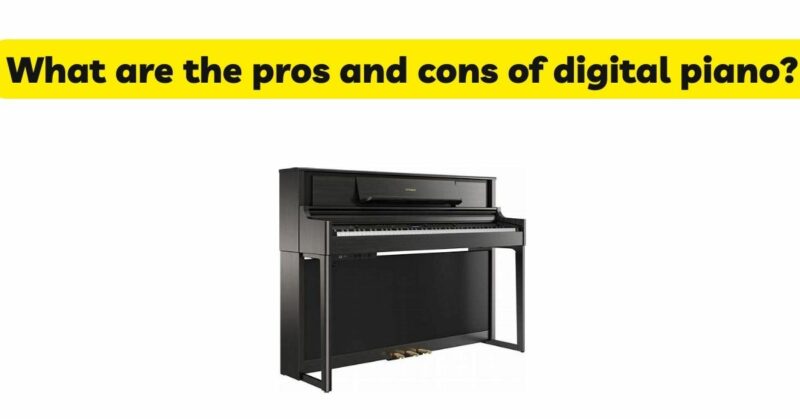Digital pianos have gained significant popularity in recent years, offering a range of features and benefits that make them attractive alternatives to acoustic pianos. However, like any musical instrument, digital pianos have their own set of advantages and disadvantages. In this article, we will explore the pros and cons of digital pianos, enabling readers to make informed decisions when considering the purchase of a digital piano.
Pros of Digital Pianos:
- Sound Versatility: Digital pianos offer a wide range of sounds beyond traditional piano tones. They often come equipped with multiple instrument voices, including strings, organs, synthesizers, and more. This versatility allows musicians to explore various genres and experiment with different sounds, expanding their creative possibilities.
- Compactness and Portability: Digital pianos are generally more compact and lightweight compared to acoustic pianos, making them easier to transport and suitable for small living spaces. Their portability allows musicians to take their instrument to gigs, rehearsals, or studios without the logistical challenges associated with moving an acoustic piano.
- Headphone Connectivity: Digital pianos often come with a headphone jack, allowing players to practice silently without disturbing others. This feature is particularly beneficial for individuals living in shared spaces or those who prefer to practice during late hours.
- Maintenance and Durability: Digital pianos require minimal maintenance compared to acoustic pianos. They do not need tuning or adjustments due to changes in temperature or humidity. Additionally, digital pianos lack mechanical components like strings and hammers, reducing the chances of wear and tear and increasing their overall durability.
- Recording and Connectivity Features: Many digital pianos offer recording capabilities, enabling musicians to capture their performances directly onto the instrument or connect it to a computer for more advanced recording and production purposes. Digital pianos also often include connectivity options like USB, MIDI, and Bluetooth, allowing seamless integration with music software and external devices.
Cons of Digital Pianos:
- Sound Authenticity: While digital pianos have made significant advancements in sound replication, they may still fall short of fully capturing the authentic tonal nuances of acoustic pianos. The complexities of resonances, harmonics, and sympathetic vibrations present in acoustic pianos are challenging to reproduce digitally, resulting in a slightly different listening experience for trained ears and experienced pianists.
- Key Action and Touch Sensitivity: Digital pianos strive to emulate the touch and feel of acoustic pianos, but some players may find the key action and touch sensitivity to be slightly different. While weighted keys with graded hammer action are commonly used, variations in key response and escapement mechanisms may affect the overall playing experience, especially for advanced pianists accustomed to the nuances of acoustic pianos.
- Dependence on Electronics and Power Supply: Digital pianos rely on electricity and electronic components for operation. Power outages or technical malfunctions can render a digital piano unusable until the issue is resolved. Moreover, the complexity of electronic components makes digital pianos more susceptible to potential technical failures or glitches over time, requiring professional assistance for repair.
- Limited Resale Value: Digital pianos, like most electronic devices, tend to depreciate in value over time. The rapid pace of technological advancements often results in newer models with improved features, making older digital pianos less desirable in the market. Acoustic pianos, on the other hand, generally retain their value better and can be considered long-term investments.
Conclusion: Digital pianos offer a wide array of benefits, including sound versatility, compactness, portability, headphone connectivity, low maintenance, and recording/connectivity features. However, they also come with limitations such as sound authenticity, key action, touch sensitivity, dependence on electronics, and limited resale value. Understanding these pros and cons is crucial in making an informed decision when considering a digital piano purchase. Ultimately, the choice between a digital piano and an acoustic piano will depend on individual preferences, musical goals, budget, and the importance placed on these factors.

